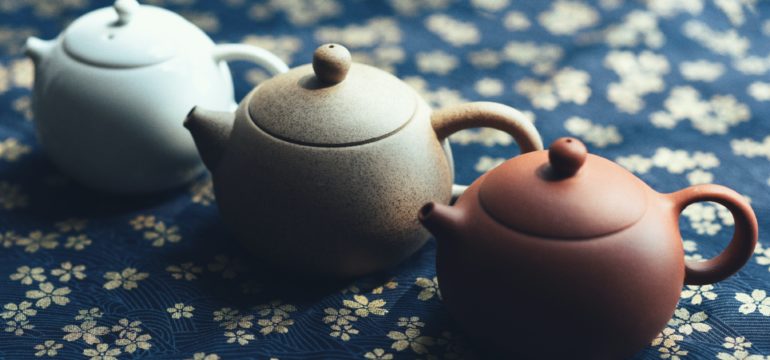By Ming Yin Kwong
Are you a tea drinker, and if so, what kind of tea pots do you usually use? Do you prefer a beautiful see-through glass tea pot, or a practical and easy to clean metal tea pot? There are plenty of options out there for purchase, made from various materials. Personally, I have seen tea pots made from glass, ceramic, or metal. For some, the tea pot is just a means to an end, while for others, their choice in tea pot is a vital part of their tea drinking ritual. Growing up, I was told that the tea pot material can change the flavor of the brewed tea, and I accepted it as a fact. However, these observations are often anecdotal. When I investigated the scientific literature, I could only find a few studies (that I can access) on how the tea pot can affect the tea being brewed in it. This article will explore some components of tea pots that may impact the quality of the brewed tea.

Photo by cottonbro from Pexels
Porous surface of the pot
Clay tea pots are often the desired material for tea pots in Chinese tea culture, especially Zisha (紫砂, purple clay) and Zhuni (朱泥, vermillion mud) from the Yixing region. These clay tea pots are traditionally known to absorb the flavor of previous brews and release them into the later brews. Through scanning electron microscopy, we know that these clay tea pots have porous surfaces. 20% by volume of the Zisha clay is filled with 0.01-0.02 mm cavities.1 It is believed that tea aroma can be trapped in these cavities and create more complex flavors in later brews. Liao et al. conducted a study where brewed oolong tea were stored in Zisha, Zhuni, ceramic, glass, stainless steel, and plastic tea pots for 5 minutes, and their chemical properties were analyzed after the storage.2 It was shown that tea stored in clay tea pots (Zisha and Zhuni) had lower amount of volatile compounds, suggesting that the clay tea pots can absorb volatile compounds responsible for the aroma of tea. However, only one compound showed a statistically significant difference, and whether these absorbed compounds could be later released into the next brew is not investigated.

Photo by Cole Hutson from StockSnap
Layer of oil from tea leaves
Another study by Chung et al. found that well-used clay tea pots were coated with an oily layer, consisting of fatty acids and linear hydrocarbon.3 The most abundant ones were palmitic acid and stearic acid, which are assumed to originate from the cell membranes of tea leaf tissues. Although we know that these fats often give a waxy flavor, without sensory analysis, it is not clear if this oily layer can change the taste of the tea brewed in these well-used tea pots. In addition, I can’t help but start to wonder if this oily layer will seal off the signature porous surfaces of these clay pots, preventing it from absorbing and releasing flavor. A comprehensive study analyzing the chemical content of the brewed tea as well as the oily layer in tea pots made from various materials might help us answer these questions.

Photo by Maria Tyutina from Pexels
Migration of pot minerals
In addition to aroma compounds and fatty acids, minerals can also affect the taste and health benefits of the brewed tea. Liao et al. found no significant difference in the minerals and heavy metal content among brewed tea stored in Zisha, Zhuni, ceramic, glass, stainless steel, or plastic tea pots.2 In another study, Petit et al. compared the metal concentration of tea brewed in stainless steel, brass, and glass teapots.4 They found lead, nickel, copper, and zinc migrating from the brass tea pot to the brewed tea, and cadmium migrating from stainless steel tea pot to the tea. Although the calculated metal content was comparable to the provisional tolerable weekly intake by the European Food Safety Authority, based on an average of 300mL of tea consumption per day, consumers might want to avoid brass tea pots to reduce heavy metal intake.

Photo by Manki Kim on Unsplash
Conclusion
It is well accepted in the tea community that the tea pot material can play a role in the final quality of the brewed tea, just like water quality, water temperature, and the tea leaves themselves can. However, scientific evidence is still lacking to support all of our anecdotal observations, namely, how much volatile compounds are trapped in clay tea pots, how much are released into later brews, if we can tell the difference through sensory analysis, and many others. More research is needed before we can turn our years of observations into scientifically backed claims.
Reference
(1) Liao Z.-H.; Chung T.-Y.; Shih Y.-E.; Hsieh S.-K.; Jiang P.-L.; Tzen J. T. C.; 廖子慧; 鍾澤裕; 施毓恩; 謝聖國; 江佩倫; 曾志正. Pot Nurturing (Yang Hu)-A Waterproof Film Coating on the Surface of Zisha Teapots. 2014.
(2) Liao, Z.-H.; Chen, Y.-J.; Tzen, J. T.-C.; Kuo, P.-C.; Lee, M.-R.; Mai, F.-D.; Rairat, T.; Chou, C.-C. Effect of Teapot Materials on the Chemical Composition of Oolong Tea Infusions. J. Sci. Food Agric. 2018, 98 (2), 751–757. https://doi.org/10.1002/jsfa.8522.
(3) Chung, T.-Y.; Kuo, P.-C.; Liao, Z.-H.; Shih, Y.-E.; Yang, M.-L.; Cheng, M.-L.; Wu, C.-C.; Tzen, J. T. C. Analysis of Lipophilic Compounds of Tea Coated on the Surface of Clay Teapots. J. Food Drug Anal. 2015, 23 (1), 71–81. https://doi.org/10.1016/j.jfda.2014.05.005.
(4) Petit, D.; El Houari, W.; Jacobs, K.; Baeyens, W.; Leermakers, M. Trace Element Content in Tea Brewed in Traditional Metallic and Stainless Steel Teapots. Environ. Monit. Assess. 2013, 185 (11), 8957–8966. https://doi.org/10.1007/s10661-013-3226-z.

Ming Yin Kwong | Linkedin
SMF Blog Writer
Ming graduated with her B.S. in Chemistry at University of California, Davis. Internship opportunities with Mi Rancho and UC Davis Olive Center made her realized her passion for Food Science. She decided to stay at UC Davis for her Ph.D. in Food Science, with a research focus on tea chemistry. When she is not crushing tea leaves or developing HPLC methods in the laboratory, Ming enjoys working out to balance the extra calories that she consumes, traveling with friends and family, watching cooking shows, and playing video games.






Leave a Reply